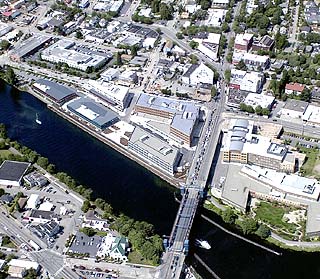
Surveys
DJC.COM
November 15, 2001
Beyond the urban core: Learning from the pioneers
The Quadrant Corp.

Conwell |
That was only a decade or two ago. Since then, high-tech office projects have sprung up in formerly overlooked places like the Elliott Avenue corridor and Bothell, and employees increasingly look for jobs where they can bike, skate or paddle to work.
The Quadrant Corp. was a local pioneer in this movement with Quadrant Lake Union Center on the Lake Washington Ship Canal.
At the outset, funky Fremont was an unlikely spot for a 20-acre tech/office campus. Admittedly, the project had its challenges. Yet it became a real success, with “Fremonsters” using the new plazas and open areas for everything from solstice celebrations to enhanced access to the Burke Gilman trail.
We learned a lot from our Fremont experience. So did much of the development community.
Here are a few lessons we see being applied today to other high-density projects around the Sound.
‘Looks’ can be everything

Photo by Soundview Photography Quadrant Lake Union Center in Fremont — home to Adobe Systems, Getty Images and other high-profile tenants — features stunning waterfront views plus access to the Burke Gilman Trail.
|
Quadrant worked with a handful of different architects as each phase evolved on the Lake Union project, passing along words to the wise to development teams. For instance, getting neighborhood feedback on building features early in the process was key to a smooth acceptance among our residential neighbors.
An emphasis during the entire design program was to insure that each new building fit into the architectural style of the existing buildings, giving rise to such features as the stucco and block exterior of the Evanston Building and the painted corrugated metal skins found on multiple buildings, among others.
You’ll see similar neighborhood sensitivity at Northwest Landing in DuPont where the small-town look of the entire master planned community reflects historic DuPont, an old company town. Front porches, garages placed in back and cozy, slim lots have been principal factors in residential appeal — resulting in current sales of one home a day.
With Intel and State Farm as lead anchors, creating important employment opportunities in an area that has previously not seen much office and technology development, the DuPont project has available land and a very promising future.
Snoqualmie Ridge is another example of the “new urbanism,” where homes and office buildings are carefully coordinated to relate to the style of structures in the historic town of Snoqualmie. So is Redmond Ridge, where design elements of many structures point to a “national park” lodge theme, and adornments in community centers, bus kiosks and office buildings all relate to the forested feel of the location.
Getting along with the neighbors
Thoughtful architecture, unfortunately, does not guarantee public acceptance of a development. Let’s face it: Residents of the state approved the Growth Management Act to encourage densification, but nobody wants increased density changing the flavor of their neighborhood.
Resistance to development of any kind is often a common theme, whether we’re talking about Fremont, Magnolia, Bellevue or Renton.
Quadrant utilized a number of approaches in securing consensus and buy-in from the Fremont community. We found that it’s always best to manage conflict before passions get out of control. That means resolving issues before they get played out in the press.
Also, it’s wise to encourage a long-term perspective on everyone’s part and not get caught up solely in projected inconveniences that come with construction activity. Soliciting and listening to the feelings of all stakeholders, accomplished with open houses and community outreach programs, helps a lot.
We now plan a wide variety of activities like these in all developments, and see other developers following the same pattern.
We also try and go the extra mile to protect neighbors from construction impacts, including additional flaggers and traffic controls, notification about brief scheduled power outages, and informing neighbors of haul routes and heaviest trucking hours.
Quadrant will use all these tactics at Kirkland 424, a new 140,000-square-foot office building, to ease the building into downtown Kirkland with minimal disruption.
Timing must be right
Another concern is appropriate timing. In hindsight, Quadrant Lake Union Center was a bit ahead of its time, both in market readiness and in concept adoption. When building permits were secured on the first three buildings, neither the overall market nor the recognition of Fremont as a desirable location for office and technology occupants had “seasoned.”
The decision by Adobe Systems to locate its Seattle headquarters to the site was the market validation that the project awaited. With the growth of technology companies seeking to capitalize on the amenities of such a location and the overall expansion of the market, Quadrant Lake Union Center proved to be a project whose time did certainly come.
The re-development we’re seeing in the Elliott Avenue corridor in Seattle exemplifies a similar movement. Immunex’s huge Helix project and the office project by Keohler McFadyen are transforming an area that had previously been home to lumberyards and industrial piers. It’s an exciting re-vitalization.
The current slowing in new development activity will not last forever. When the next economic cycle sweeps through, developers will be working to make new projects work in pioneering or overlooked locations again. They will be eyeing places like Ballard, Interbay and north Rainier Avenue — where amenities and neighborhood cultures will likely attract the next generation of office and technology occupants.
Such neighborhoods have charm, great lifestyle elements and high populations of well-educated residents who would no doubt like to live closer to work.
Timing is relative, though, because visionaries who build mixed-use high-density projects in neighborhoods cause inevitable change. Consider the perceived crime levels in Pioneer Square when Aldus and Immunex were start-ups there. Today, however, you rarely hear anyone complain about physical safety when going to Pioneer Square for business.
That’s the power that superior-quality tenants have to transform an area’s character. Once firmly established, they attract other successful tenants like magnets, often resolving the very issues that made property values low in the first place.
What’s in the wind?
Quadrant is actively looking for locations with similar amenities and appeal as Fremont. We believe that the potential for high-density commercial/residential projects is huge — in areas where mixed-use already has a foothold, and possibly in areas that are not fully validated yet.
Anywhere on Lake Union is an obvious candidate for future development, given its proximity to the University of Washington, Fred Hutchinson Cancer Center, ZymoGenetics, Adobe Systems, Getty Images and WRQ. So are Ballard, Elliott Avenue and Interbay.
The Eastside will continue to be another prime area. People are increasingly unwilling to commute across clogged bridges, and traffic is becoming such a headache that many will want to use alternate transportation even when not crossing the water.
Living within walking or bicycling distance of work. Riding a skateboard for espresso on your morning break. Throwing a Frisbee at the park during lunch. These lifestyle dreams are being lived at Quadrant Lake Union Center. And they will increasingly be at other developments around Puget Sound where workspace is combined with outdoor and urban amenities — and the principles of style, timing and community sensitivity that we learned in Fremont are carefully applied.
Benjamin D. Conwell is vice president of operations for Quadrant Corp.’s commercial division. Bellevue-based Quadrant is a subsidiary of Weyerhaeuser Real Estate Co.
Other Stories:
- A peek into the architectural process
- Achieving design certainty through collaboration
- Getting a project off the ground
- Head and shoulders above Sea-Tac
- High-rise homes with all the right stuff
- So you’re in it for the money
- What you need to know about your competitors
- Thea’s Landing: Downtown Tacoma’s new urban housing
- Rebirth of a Commencement Bay chateau
- New museum will have Tacomans glassy-eyed
- Controlling stormwater the natural way
- A cap over troubled waters
- Orchestrating Belltown’s rebirth
- Mechanical moxie: Innovations at the new Opera House
- Preserving a church gets personal
- Small housing: A Northwest mini-trend
- Delivering the goods in a tight economy
- Don’t overlook moisture — the silent threat
- Designing a one-building ‘city’ on a Norwegian fjord
- The changing face of retail design
- Preserving affordable housing by design
- Hospitality industry draws on refuge and prospect
Copyright ©2009 Seattle Daily Journal and DJC.COM.
Comments? Questions? Contact us.